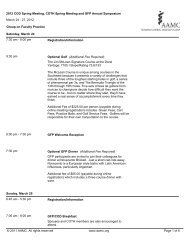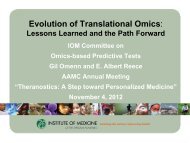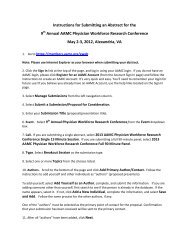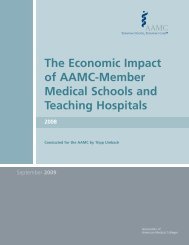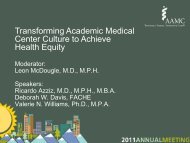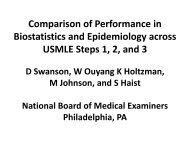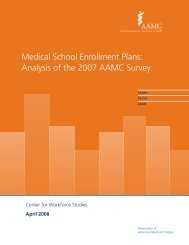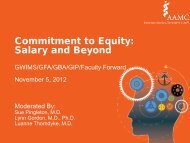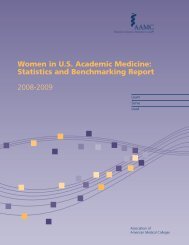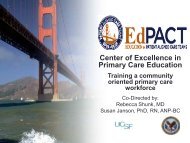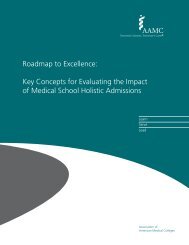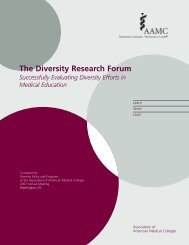Finishing the Bridge to Diversity - Member Profile - AAMC
Finishing the Bridge to Diversity - Member Profile - AAMC
Finishing the Bridge to Diversity - Member Profile - AAMC
Create successful ePaper yourself
Turn your PDF publications into a flip-book with our unique Google optimized e-Paper software.
<strong>Finishing</strong> <strong>the</strong> <strong>Bridge</strong> <strong>to</strong> <strong>Diversity</strong><br />
160%. The result, as<br />
shown in Figure 3, is<br />
that somewhere in <strong>the</strong><br />
middle of <strong>the</strong> next century,<br />
<strong>the</strong> majority of our<br />
citizens will be members<br />
of minority groups.<br />
So what What do<br />
<strong>the</strong>se striking demographic<br />
trends describing <strong>the</strong><br />
future complexion of<br />
America have <strong>to</strong> do with<br />
our responsibilities as<br />
stewards of medicine’s<br />
future I find <strong>the</strong> answer<br />
<strong>to</strong> that question pretty<br />
straightforward. Academic<br />
medicine is, after all, largely<br />
about <strong>the</strong> future. It’s about<br />
Percent<br />
100<br />
80<br />
60<br />
40<br />
20<br />
The Future Complexion<br />
of America<br />
0<br />
1980 1990 2000 2010 2020 2030 2040 2050<br />
YEAR<br />
improving <strong>the</strong> health of future generations by educating <strong>the</strong> physicians who<br />
will care for <strong>to</strong>morrow’s children, and by discovering better ways <strong>to</strong> keep<br />
<strong>to</strong>morrow’s children healthy. Given that our primary obligation <strong>to</strong> society is <strong>to</strong><br />
furnish it with a physician workforce appropriate <strong>to</strong> its needs, our mandate is<br />
<strong>to</strong> select and prepare students for <strong>the</strong> profession who, in <strong>the</strong> aggregate, bear a<br />
reasonable resemblance <strong>to</strong> <strong>the</strong> racial, ethnic, and of course, gender profiles of<br />
<strong>the</strong> people <strong>the</strong>y<br />
will serve. In<br />
Academic medicine is, after all, largely about <strong>the</strong> future. It’s about<br />
o<strong>the</strong>r words, a<br />
improving <strong>the</strong> health of future generations by educating <strong>the</strong> physicians<br />
medical profession<br />
that looks<br />
who will care for <strong>to</strong>morrow’s children, and by discovering better ways<br />
like America. We <strong>to</strong> keep <strong>to</strong>morrow’s children healthy.<br />
have made substantial<br />
progress on this front with respect <strong>to</strong> gender; but, as <strong>the</strong>se data suggest,<br />
we’ve still got a long, long way <strong>to</strong> go with respect <strong>to</strong> race and ethnicity.<br />
But why should anyone care if <strong>the</strong> medical profession reflects society’s<br />
racial and ethnic makeup as long as we have plenty of well-trained practitioners<br />
of whatever background The reasons are many. Let me mention five that<br />
stand out in my mind:<br />
Asian<br />
Hispanic<br />
Native<br />
American<br />
Black<br />
White<br />
Figure 3. Changes and projected changes in <strong>the</strong> relative sizes of five racial-ethnic groups in <strong>the</strong><br />
U.S. population, 1980-2050.<br />
3



